When I got back from the Amherst Today poetry workshop last month I was all pumped up to write about the classes I sat in on earlier in the day. This was easy for me to do, tapping into the scholar/teacher and Amherst grad in me and playing off my actual work of the past years, which among other things includes promoting American higher education methods abroad.
Writing about the poetry seminar itself is proving harder. Apart from the intrusion of the High Holidays, work, lack of sleep and other daily distractions upon my nighttime window of lucid thinking / writing time (even now, a 10:30PM cry of “Mom!” from upstairs has had to be answered–you can imagine how happy the caller was to see me turn up instead), the seminar was a sort of primal scene for me. Being a poet was a major way I defined myself from about ages 16-25, peaking more or less in writing my Amherst thesis with David Sofield, the seminar’s organizer. Then I wrote a PhD about a poet, Adrienne Rich, and along the way found myself with less time and state of mind to be inspired to write myself (on inspiration as prerequisite, more later). And then, not to belabor the point, I lost my brother in 9/11, and felt that the topics I’d written on before were trivial, and that I could not bear to take on the new topic that had been handed to me.
In the weeks before the seminar, which included the 9/11 anniversary, I was inspired to engage with poetry in a way I had not in many years, reading up on Merrill and Ferry and interviewing Dan Chiasson. I even wrote a poem on The Topic for the first time and still feel OK about it. So in somewhat prodigal son fashion, coming back to Amherst to meet my two main faculty mentors (David Sofield and Bill Pritchard) stirred powerful emotions and reopened old mental pathways.
Presented here are just some highlights from our discussions of Merrill and Ferry, links to the poems we discussed in the seminar for the gung ho reader, and some impressions from the reading afterwards.
Reading James Merrill
David Sofield started our two-plus hours of reading James Merrill’s works by evoking as muse the spirit of “appreciative mediation” that he had attributed to his co-seminar leader, Richard Wilbur, as part of a book honoring Bill Pritchard (whew!). We ended up having time only for reading and discussion of five poems. Nestled in the Red Room in Converse, hearing Sofield and Wilbur read, and Sofield explicate both meter and emotion with the patience and grace of a Midwestern Virgil (or Ephraim) was exactly the inspiring experience the seminar might have advertised. Beyond this was the sense of the audience being equally incisive and engaged–including, ahem, Nobel Laureate Harold Varmus ’61, in the fine tradition of Amherst poetic docs–and getting brief electric shocks from Wilbur, Pritchard and co. as they evoked moments of connection to Merrill and back into the American canon.
From this urban and urbane scene we moved to a bank vault underneath the city, the setting for “The Emerald.” Paired in the two-part “Up and Down” with a poem set atop a mountain, this poem descends into what Wilbur pointed out was something like the underworld, one that Ferry compared to Aeneid Book VI (which he is now translating). What stays with me here is Merrill taking the occasion of his mother’s gift to him of an emerald ring “for when you marry” to point out gently that “this green room’s mine, my very life. / We are each other’s; there will be no wife; / The little feet that patter here are metrical.” This is one of his brilliant evocations of what he calls in The Book of Ephraim “the world in the poem and the poem in the world.”
The Emerald (from Up and Down)
Reading David Ferry
I had only read the very occasional poem by Ferry before the seminar and it was such a gift to have this opportunity to read deeply in his translations and his incredibly powerful and compassionate poems. As I mentioned in my interview with Dan Chiasson, reading a guy like Ferry (internationally renowned translator of the Classics) really makes you wonder what the hell you were studying in college that you don’t have even a trace of what Oxbridge grads had under their waistcoats in ye olde days. But as I learned when I sat next to Ferry at dinner, he is not only a perfect gentleman and the model of the together person one aspires to be at 88, but he never actually studied the Classics! As he explained in his recent profile in Amherst magazine, he did one translation of Horace in the 80s and then a friend at Harvard, Bill Moran, “asked [him] to make verses out of his scholarly, word-for-word English translation of two passages in the Gilgamesh epic. [He] fell for the Gilgamesh and [his] rendering of it. [He] certainly didn’t start out with an ambition to become a translator. Sort of accidental, but also kind of a love story.”
I remembered seeing Bill Moran’s name in the foreword to Gilgamesh this summer and this came back when we read Brunswick, Maine, Early Winter, 2000and its unsparing, loving vision of Bill Moran bent double by Parkinson’s so that at the kitchen table he appeared to be “Intently studying a piece of toast,/ A just discovered, as yet unreadable/Mesopotamian language.” As Ferry says of his cousin in “On a Poem by Arthur R. Gold,” who bore “the obligation of being who she was,” so too some of Ferry’s most recent poems seem animated by a similar obligation: to evoke in verse a link between those he loves in extremis and the human, daily world that still surrounds them but is separated by a mortal boundary like those described in the Classical underworld. Ferry’s profound consciousness of this boundary (in life and in the poetic canon) makes the end of “Brunswick, Maine” all the more painful, as Ferry imagines a way out for Bill Moran, in which his imprisoning canvas-steel frame chair is transformed into a sling like those that “…rescue people from their sinking boats/ And carry them up under the angel wings/ To safety in the helicopter noise.”The Guest Ellen at the Supper for Street People
Brunswick, Maine, Early Winter, 2000
Reading with Dan Chiasson, Sofield, Ferry and Wilbur
The three poets/moderators plus Dan Chiasson had a reading after we discussed Ferry’s work, in which each started by reading a James Merrill poem and then their own works. I was pleased to see new Amherst President Biddy Martin turn up for part of this session (she is an English major among many other fine qualities).
For reasons cited in the intro above I was totally engaged and somewhat farklempt during this reading. The connection of our group to the readers grew in intensity, set off for me by the rain against the leaded glass and the students trudging outside, seemingly unhaunted by the grappling with mortality featured in most of the poems we heard.
Because it was so helpful for me in illuminating an already very moving poem of Merril’s, I want to close with Wilbur’s gloss on “b o d y” from Merrill’s last book. From the b of birth to the d of death lie many m”oo”ns–if we are fortunate–with the y remaining as the question of what our time means and what will we do with it. For these poets and scholars, the answer has been to work like hell to write towards the truth and maintain one’s good humor and humanity throughout.
Bonus: Video of Dan Chiasson reading from “Where’s the Moon, There’s the Moon” (filmed at his home in Sudbury, Mass. in 2010)

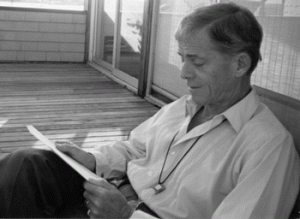
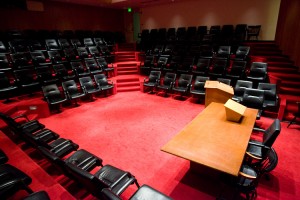
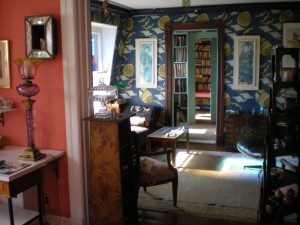

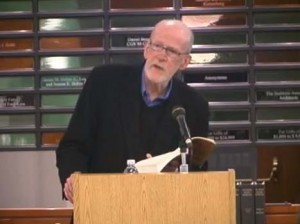
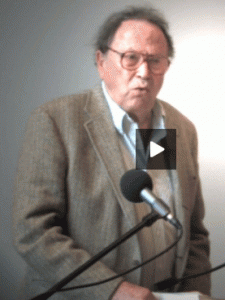
Pingback: A former acolyte remembers Adrienne Rich | Even Josh Knows | The Best Poetry Site